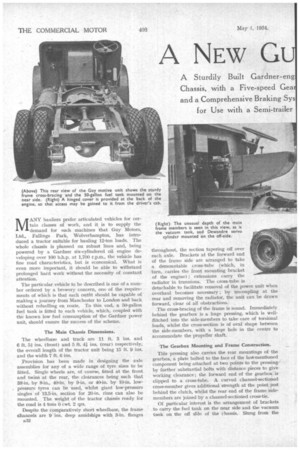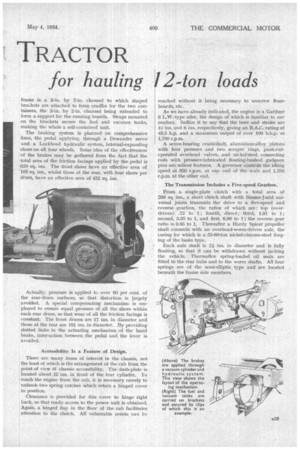A NEW G
Page 46

Page 47

If you've noticed an error in this article please click here to report it so we can fix it.
TRACTOR
for hauling
MANY hauliers prefer articulated vehicles for certain classes of work, and it is to supply the demand for such machines that Guy Motors, Ltd., Fallings Park, Wolverhampton, has introduced a tractor suitable for hauling 12-ton loads. The whole chassis is planned on robust lines and, being powered by a Gardner six-cylindered oil engine developing over 100 b.h.p. at 1,700 r.p.m., the vehicle has fine road characteristics, but is economical. What is even more important, it should be able to withstand prolonged hard work without the necessity of constant attention.
The particular vehicle to be described is one of a number ordered by a brewery concern, one of the requirements of which is that each outfit should be capable of making a journey from Manchester to London and back without refuelling en route. To this end, a 50-gallon fuel tank is fitted to each vehicle, which, coupled with theknown low fuel consumption of the Gardner power unit, should ensure the success of the scheme.
The Main Chassis Dimensions.
The wheelbase and track are 11 ft. 3 ins. and 6 ft. 51 ins. (front) and 5 ft. 4'4 ins. (rear) respectively, the overall length of the tractor unit being 15 ft. 9 ins. and the width 7 ft. 6 ins.
Provision has been made in designing the axle assemblies for any of a wide range of tyre sizes to be fitted. Single wheels are, of course, fitted at the front and twins at the rear, the clearances being such that 38-in. by 8-in., 40-in. by 9-in. or 40-in. by 10-in, lowpressure tyres can be used, whilst giant low-pressure singles of 13.5-in. section for 20-in, rims can also be mounted. The weight of the tractor chassis ready for the road is 4 tons 0 cwt. 2 qrs.
Despite the comparatively short wheelbase, the frame channels are 9 ins, deep amidships with 3-in, flanges u32 throughout, the section tapering off over each axle. Brackets at the forward end of the frame side are arranged to take a demountable cross-tube (which, in turn, carries the front mounting bracket of the engine) ; extensions carry the radiator in trunnions. The cross-tube is detachable to facilitate removal of the power unit when overhaul becomes necessary ; by uncoupling at the rear and removing the radiator, the unit can be drawn forward, clear of all obstructions.
The cross-bracing of the frame is sound. Immediately behind the gearbox is a huge pressing, which is wellhitched into the side-members to take care of torsional loads, whilst the cross-section is of oval shape between the side-members, with a large hole in the centre to accommodate the propeller shaft.
'The Gearbox Mounting and Frame Construction.
This pressing also carries the rear mountings of the gearbox, a plate bolted to the face of the last-mentioned component being attached at two points to the pressing,
by further substantial bolts with distance pieces to give working clearance ; the forward end of the gearbox is clipped to a cross-tube. A curved channel-sectioned cross-mentber gives additional strength at the point just behind the clutch, whilst the rear end of the frame sidemembers are joined by a channel-sectioned cross-tie.
Of particular interest is the arrangement of brackets to carry the fuel tank on the near side and the vacuum tank on the off side of the chassis. Slung from the frame is a 3-in. by 2-in, channel to which shaped brackets are attached to form cradles for the two containers, the 3-in. by 2-in, channel being extended to form a support for the running boards. Straps mounted on the brackets secure the fuel and vacuum tanks, making the whole a self-contained unit.
The braking system is planned on comprehensive lines, the pedal applying, through a Dewandre servo and a Lockheed hydraulic system, internal-expanding shoes on all four wheels. Some idea of the effectiveness of the brakes may be gathered from the fact that the total area of the friction facings applied by the pedal is 620 sq. ins. The front shoes have an effective area of 168 sq. ins., whilst those at the rear, with four shoes per drum, have an effective area of 452 sq. ins.
Actually, pressure is applied to over 90 per cent, of the rear-drum surfaces, so that distortion is largely avoided. A special compensating mechanism is employed to ensure equal pressure of all the shoes within each rear drum, so that wear of all the friction facings is constant. The front drums are 17 ins. 'in diameter and those at the rear are 16+ ins, in diameter.. By providing slotted links in the actuating mechanism of the hand brake, inter-action between the pedal and the lever is avoided.
Accessibility Is a Feature of Design.
There are many items of interest in the chassis, not the least of which is the arrangement of the cab from the point of view of chassis accessibility. The dash-plate is located about 12 ins, in front of the rear cylinder. To reach the engine from the cab, it is necessary merely to unhook two spring catches which retain a hinged cover in position.
Clearance is provided for this cover to hinge right back, so that ready access to the power unit is obtained. Again, a hinged flap in the floor of the cab facilitates attention to the clutch. All vulnerable points can be
I4reached without it being necessary to unscrew floor
boards, etc. . As we have already indicated, the engine is a Gardner 6 L.W.-type oiler, the design of which is familiar to our readers. Suffice it to say that the bore and stroke are 41 ins. and 6 ins, respectively, giving an R.A.C. rating of 3.5 h.p. and a maximum output of over 100 b.h.p. at 1,700 r.p.m. A seven-bearing crankshaft, aluminium-alloy pistons with four pressure and two scraper rings, push-rodoperated overhead valves, and nickel-steel connecting rods with pressure-lubricated floating-bushed gudgeon pins are salient features. A governor controls the idling speed at 350 r.p.m. at one end of the scale and 1,550 r.p.m. at the other end.
2-ton loads
The Transmission Includes a Five-speed Gearbox.
From a single-plate clutch with a total area of 298 sq. ins., a short clutch shaft with Simms-jurid universal joints transmits the drive to a five-speed and reverse gearbox, the ratios of which are : top (overdriven) .72 to 1; fourth, direct ; third, 1.91 to 1; second, 3.35 to 1, and first, 6.98 to 1; the reverse gear ratio is 9.85 to 1. Thereafter a Hardy Spicer propeller shaft connects with an overhead-worm-driven axle, the casing for which is a 55-60-ton nickel-chrome-steel forging of the basin type.
Each axle shaft is 21 ins, in diameter and is fully floating, so that it can be withdrawn without jacking the vehicle. Thermoflex spring-loaded oil seals are fitted to the rear hubs and to the worm shafts. All four springs are of the semi-elliptic type and are located beneath the frame side members.




























































































